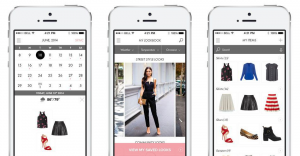Problem
Consumers often do not know how to create the PERFECT outfit for an important event or they don’t know how to combine the articles of clothing they currently own into a good outfit.
Consumers may forget clothing items they already have hiding in their closet, so these items stay on the hanger underused. Or, an individual may have 80% of an outfit that would fit their preferences, but they don’t know what to add to complete the ensemble or simply, they’re unsure what’s appropriate for a specific social event coming up on their calendar.
Solution
What’s in Your Closet, WIYC, would help these consumers better understand how to maximize the items already in their closet or find pieces to complete a look via relevant offline or online channels.
To use What’s in Your Closet, the customer will first need to add photos of their current closet inventory. This can either be an upload of the customer’s personal photos and/or transfer of items found from online transactions (e.g. receipt from Nordstrom, complete with item photos) to the customer’s account. Once their closet is ‘complete’ in their account, they can add color with style preferences so the algorithm can make the best recommendations in the future.
Then, the customer can come to their WIYC account when they are struggling to find an outfit. They can input detail on a particular event or occasion (wedding, cocktail event, formal), and then the algorithm will take into consideration what you wore on recent occasions, seasonal and weather details, your budget, and your ideal fashion style.
What’s in Your Closet will then offer three suggestions based on your time constraints and preferences.
- 1-2 outfit recommendations based on what’s currently in your closet.
- 1-2 outfit recommendations based on what’s available locally in stores, or online, and which you can purchase in time for the event (coupled with items like shoes and accessories that are currently in your closet).
- 1-2 outfit recommendations based on items in your friends’ closests, if you elect to participate in social networking through the app and “share” your closet with others (coupled with items like shoes and accessories that are currently in your closet)
Pilot & the future
The solution will be piloted across a target audience of young, fashion-minded women, potentially college students. This will be ideal as this audience will likely have less items to ‘catalogue’ into their account, so therefore can get up and running more quickly but at the same time have a high need for frequent outfits for social settings.
As the application is rolled out to a wider audience, the algorithm will be able to make even better recommendations as it receives more inputs on what outfits work or don’t work for particular types of customers. For example: by body type, by style, by location, by occasion.
In the future, ideally the application would be able to function as well as or better than a human stylist and personal shopper.
Risks and Competition
Currently, the typical alternative to this type of product are people (fashion advisors, department store sales reps) that advise customers on their apparel when making a purchase. Furthermore, online department stores such as Amazon will suggest outfits and articles of clothing based on previous clothing purchases. Because What’s in Your Closet caters to consumers who are looking to create ensembles based on what they currently own, closer competitors are websites and applications that suggest outfits based on what the user types in.
In addition, there are some technology companies that play in a similar space, but do not tailor based on current items in ones’ closet. Stitch Fix, for example, deploys algorithms to predict which clothing attributes customers will prefer based on a created style profile and then deliver preferred items to the customer’s doorstep to try on. Other services, like Wantable, also combine predictions based on a personal style profile or quiz.
The key risks to this application involve user engagement. This would require customers to ensure that their items are somehow catalogued into their profile so that the application can share which items look best together based on the event, day, etc. However, once customers are fully engaged in the application and have items logged in, they will be less likely to leave.
Exit options
Some potential buyers for What’s In Your Closet include major departments stores and retailers like Nordstrom, Lord and Taylor, H&M, and others. This could also appeal to online-only brands such as Cuyana or Nasty Gal.
Sources:
[1] http://www.vogue.co.uk/article/future-of-fashion-artificial-intelligence-post-material-world
[2] https://www.businessoffashion.com/articles/intelligence/top-industry-trends-2018-7-ai-gets-real
[3] https://www.stitchfix.com/
[4] http://fortune.com/2018/03/15/fashion-ai-artificial-intelligence-future-kim-kardashian/
[5] https://fashionista.com/2017/11/fashion-brands-stylists-ai-artificial-intelligence-chatbots
Team members:
Pavlina Plasilova, Kelly de Klerk, Yuxiao Zhang, Aziz Munir, Megan McDonald
